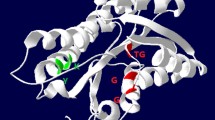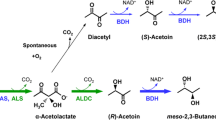Abstract
An efficient cofactor regeneration system has been developed to provide a hydride source for the preparation of optically pure alcohols by carbonyl reductase-catalyzed asymmetric reduction. This system employed a novel glucose dehydrogenase (BcGDH90) from Bacillus cereus HBL-AI. The gene encoding BcGDH90 was found through the genome-wide functional annotation. Homology-built model study revealed that BcGDH90 was a homo-tetramer, and each subunit was composed of βD-αE-αF-αG-βG motif, which was responsible for substrate binding and tetramer formation. The gene of BcGDH90 was cloned and expressed in Escherichia coli. The recombinant BcGDH90 exhibited maximum activity of 45.3 U/mg at pH 9.0 and 40 °C. BcGDH90 showed high stability in a wide pH range of 4.0–10.0 and was stable after the incubation at 55 °C for 5 h. BcGDH90 was not a metal ion-dependent enzyme, but Zn2+ could seriously inhibit its activity. BcGDH90 displayed excellent tolerance to 90% of acetone, methanol, ethanol, n-propanol, and isopropanol. Furthermore, BcGDH90 was applied to regenerate NADPH for the asymmetric biosynthesis of (S)-(+)-1-phenyl-1,2-ethanediol ((S)-PED) from hydroxyacetophenone (2-HAP) with high concentration, which increased the final efficiency by 59.4%. These results suggest that BcGDH90 is potentially useful for coenzyme regeneration in the biological reduction.





Similar content being viewed by others
Data Availability
All data are provided in the manuscript, or in supplementary material, or will be available to researchers on reasonable request.
References
Iyanagi, T. (2019). Molecular mechanism of metabolic NAD(P)H-dependent electron-transfer systems: The role of redox cofactors. Biochimica et Biophysica Acta (BBA)-Bioenergetics, 1860, 233–258. https://doi.org/10.1016/j.bbabio.2018.11.014
Calzadiaz-Ramirez, L., & Meyer, A. S. (2022). Formate dehydrogenases for CO2 utilization. Current Opinion in Biotechnology, 73, 95–100. https://doi.org/10.1016/j.copbio.2021.07.011
Lauterbach, L., Lenz, O., & Vincent, K. A. (2013). H(2)-driven cofactor regeneration with NAD(P)(+)-reducing hydrogenases. The FEBS Journal, 280, 3058–3068. https://doi.org/10.1111/febs.12245
Fukuzumi, S., Lee, Y. M., & Nam, W. (2017). Artificial photosynthesis for production of ATP, NAD(P)H, and hydrogen peroxide. ChemPhotoChem, 2, 121–135. https://doi.org/10.1002/cptc.201700146
Megarity, C. F., Siritanaratkul, B., Heath, R. S., Wan, L., Morello, G., FitzPatrick, S. R., Booth, R. L., Sills, A. J., Robertson, A. W., Warner, J. H., Turner, N. J., & Armstrong, F. A. (2019). Electrocatalytic volleyball: Rapid nanoconfined nicotinamide cycling for organic synthesis in electrode pores. Angewandte Chemie International Edition, 58, 4948–4952. https://doi.org/10.1002/anie.201814370
Hollmann, F., Arends, I. W. C. E., & Holtmann, D. (2011). Enzymatic reductions for the chemist. Green Chemistry, 13. https://doi.org/10.1039/c1gc15424a
Wang, X., Saba, T., Yiu, H. H. P., Howe, R. F., Anderson, J. A., & Shi, J. (2017). Cofactor NAD(P)H regeneration inspired by heterogeneous pathways. Chem, 2, 621–654. https://doi.org/10.1016/j.chempr.2017.04.009
Chen, X. J., Ding, H. T., Du, Y. Q., Lin, H., Li, Z. L., & Zhao, Y. H. (2011). Cloning, expression and characterization of a glucose dehydrogenase from Bacillus sp G3 in Escherichia coli African Journal of Microbiology Research, 5, 5882–5888. https://doi.org/10.5897/ajmr11.831
Jörnvall, H., Persson, B., Krook, M., Atrian, S., Gonzalez-Duarte, R., Jeffery, J., & Ghosh, D. (1995). Short-chain dehydrogenases/reductases (SDR). Biochemistry, 34, 6003–6013.
Yamamoto, K., Kurisu, G., Kusunoki, M., Tabata, S., Urabe, I., & Osaki, S. (2001). Crystal structure of glucose dehydrogenase from Bacillus megaterium IWG3 at 1.7 Å resolution. The Journal of Biochemistry, 129, 303–312. https://doi.org/10.1093/oxfordjournals.jbchem.a002858
Haq, S. F., Shanbhag, A. P., Karthikeyan, S., Hassan, I., Thanukrishnan, K., Ashok, A., Sukumaran, S., Ramaswamy, S., Bharatham, N., Datta, S., Samant, S., & Katagihallimath, N. (2018). A strategy to identify a ketoreductase that preferentially synthesizes pharmaceutically relevant (S)-alcohols using whole-cell biotransformation. Microbial Cell Factories, 17. https://doi.org/10.1186/s12934-018-1036-2
Liu, J., & Li, Z. (2019). Enhancing cofactor recycling in the bioconversion of racemic alcohols to chiral amines with alcohol dehydrogenase and amine dehydrogenase by coupling cells and cell-free system. Biotechnology and Bioengineering, 116, 536–542. https://doi.org/10.1002/bit.26896
Mordhorst, S., & Andexer, J. N. (2020). Round, round we go - Strategies for enzymatic cofactor regeneration. Natural Product Reports, 37, 1316–1333. https://doi.org/10.1039/d0np00004c
Nidetzky, B., Neuhauser, W., Haltrich, D., & Kulbe, K. D. (1996). Continuous enzymatic production of xylitol with simultaneous coenzyme regeneration in a charged membrane reactor. Biotechnology and Bioengineering, 52, 387–396. https://doi.org/10.1002/(SICI)1097-0290(19961105)52:3<387::AID-BIT4>3.0.CO;2-G
Gröger, H., Chamouleau, F., Orologas, N., Rollmann, C., Drauz, K., Hummel, W., Weckbecker, A., & May, O. (2006). Enantioselective reduction of ketones with “designer cells” at high substrate concentrations: Highly efficient access to functionalized optically active alcohols. Angewandte Chemie International Edition, 45, 5677–5681. https://doi.org/10.1002/anie.200503394
Li, J. X., Huang, Y. Y., Chen, X. R., Du, Q. S., Meng, J. Z., Xie, N. Z., & Huang, R. B. (2018). Enhanced production of optical (S)-acetoin by a recombinant Escherichia coli whole-cell biocatalyst with NADH regeneration. RSC Advances, 8, 30512–30519. https://doi.org/10.1039/c8ra06260a
Shao, M., Zhang, X., Rao, Z., Xu, M., Yang, T., Li, H., Xu, Z., & Yang, S. (2016). Efficient testosterone production by engineered Pichia pastoris co-expressing human 17β-hydroxysteroid dehydrogenase type 3 and Saccharomyces cerevisiae glucose 6-phosphate dehydrogenase with NADPH regeneration. Green Chemistry, 18, 1774–1784. https://doi.org/10.1039/c5gc02353j
Stolarczyk, K., Rogalski, J., & Bilewicz, R. (2020). NAD(P)-dependent glucose dehydrogenase: Applications for biosensors, bioelectrodes, and biofuel cells. Bioelectrochemistry, 135. https://doi.org/10.1016/j.bioelechem.2020.107574
Boontim, N., Yoshimune, K., Lumyong, S., & Moriguchi, M. (2006). Cloning of D-glucose dehydrogenase with a narrow substrate specificity from Bacillus thuringiensis M15. Annals of Microbiology, 56, 237–240. https://doi.org/10.1007/bf03175011
Wu, X. Y., Ding, H. T., Ke, L. P., Xin, Y. Y., & Cheng, X. F. (2012). Characterization of an acid-resistant glucose 1-dehydrogenase from Bacillus cereus var. Mycoides Romanian Biotechnological Letters, 17, 7540–7548. https://doi.org/10.1016/j.syapm.2012.04.005
Bach, J. A., & Sadoff, H. L. (1962). Aerobic sporulating bacteria I. Journal of Bacteriology, 83, 699–707. https://doi.org/10.1128/jb.83.4.699-707.1962
Wong, C. H., & Drueckhammer, D. G. (1985). Enzymatic synthesis of chiral hydroxy compounds using immobilized glucose dehydrogenase from Bacillus cereus for NAD(P)H regeneration. Nature Biotechnology, 3, 649–651. https://doi.org/10.1038/nbt0785-649
Wong, C., Drueckhammer, D. G., & Sweers, H. M. (1985). Enzymatic vs. fermentative synthesis: Thermostable glucose dehydrogenase catalyzed regeneration of NAD(P)H for use in enzymatic synthesis. Journal of the American Chemical Society, 107, 4028–4031. https://doi.org/10.1021/ja00299a044
Shah, S., Sunder, A. V., Singh, P., & Wangikar, P. P. (2020). Characterization and application of a robust glucose dehydrogenase from Paenibacillus pini for cofactor regeneration in Biocatalysis. Indian Journal of Microbiology, 60, 87–95. https://doi.org/10.1007/s12088-019-00834-w
Pongtharangkul, T., Chuekitkumchorn, P., Suwanampa, N., Payongsri, P., Honda, K., & Panbangred, W. (2015). Kinetic properties and stability of glucose dehydrogenase from Bacillus amyloliquefaciens SB5 and its potential for cofactor regeneration. AMB Express, 5, 68. https://doi.org/10.1186/s13568-015-0157-9
Ding, H. T., Du, Y. Q., Liu, D. F., Li, Z. L., Chen, X. J., & Zhao, Y. H. (2011). Cloning and expression in E. coli of an organic solvent-tolerant and alkali-resistant glucose 1-dehydrogenase from Lysinibacillus sphaericus G10. Bioresource Technology, 102, 1528–1536. https://doi.org/10.1016/j.biortech.2010.08.018
Zhang, H. L., Zhang, C., Pei, C. H., Han, M. N., Xu, Z. D., Li, C. H., & Li, W. (2018). Efficient production of trans-4-Hydroxy-l-proline from glucose by metabolic engineering of recombinant Escherichia coli Letters in Applied Microbiology, 66, 400–408. https://doi.org/10.1111/lam.12864
Wang, X. M., Han, M. N., Jiang, J. P., Fu, S. Q., Zhang, F. H., Du, J., Zhang, H. L., & Li, W. (2021). Isolation of a Bacillus cereus strain HBL-AI and its application for production of Trans-4-hydroxy-l-proline. Letters in Applied Microbiology, 72, 53–59. https://doi.org/10.1111/lam.13388
Zhang, H. L., Zhang, C., Han, M. N., Pei, C. H., Xu, Z. D., & Li, W. (2018). Efficient biosynthesis of enantiopure tolvaptan by utilizing alcohol dehydrogenase-catalyzed enantioselective reduction [10.1039/C7GC03679E]. Green Chemistry, 20, 1224–1227. https://doi.org/10.1039/C7GC03679E
Jiang, J., Han, M., Fu, S., Du, J., Wang, S., Zhang, H., & Li, W. (2021). Enhanced production of Iturin A-2 generated from Bacillus velezensis T701 and the antitumor activity of Iturin A-2 against human gastric carcinoma cells. International Journal of Peptide Research and Therapeutics, 28, 27. https://doi.org/10.1007/s10989-021-10340-7
Han, M. N., Wang, X. M., Pei, C. H., Zhang, C., Xu, Z., Zhang, H. L., & Li, W. (2021). Green and scalable synthesis of chiral aromatic alcohols through an efficient biocatalytic system. Microbial Biotechnology, 14, 444–452. https://doi.org/10.1111/1751-7915.13602
Zhang, H. L., Zhang, C., Pei, C. H., Han, M. N., & Li, W. (2019). Enantioselective synthesis of enantiopure chiral alcohols using carbonyl reductases screened from Yarrowia lipolytica Journal of Applied Microbiology, 126, 127–137. https://doi.org/10.1111/jam.14125
Makino, Y., Negoro, S., Urabe, I., & Okada, H. (1989). Stability-increasing mutants of glucose dehydrogenase from Bacillus megaterium IWG3. Journal of Biological Chemistry, 264, 6381–6385. https://doi.org/10.1016/s0021-9258(18)83360-9
Nishioka, T., Yasutake, Y., Nishiya, Y., & Tamura, T. (2012). Structure-guided mutagenesis for the improvement of substrate specificity of Bacillus megaterium glucose 1-dehydrogenase IV. The FEBS Journal, 279, 3264–3275. https://doi.org/10.1111/j.1742-4658.2012.08713.x
Goldman, M., & Blumenthal, H. J. (1964). Pathways of glucose catabolism in Bacillus cereus Journal of Bacteriology, 87, 377–386. https://doi.org/10.1128/jb.87.2.377-386.1964
Vitolo, M. (2020). Brief review on enzyme activity. World Journal of Pharmaceutical Research, 9, 60–76. https://doi.org/10.20959/wjpr20202-16660
Fujita, Y., Ramaley, R., & Freese, E. (1977). Location and properties of glucose dehydrogenase in sporulating cells and spores of Bacillus subtilis Journal of Bacteriology, 132, 282–293. https://doi.org/10.1128/jb.132.1.282-293.1977
Mitamura, T., Urabe, I., & Okada, H. (1989). Enzymatic properties of isozymes and variants of glucose dehydrogenase from Bacillus megaterium European Journal of Biochemistry, 186, 389–393. https://doi.org/10.1111/j.1432-1033.1989.tb15221.x
Boontim, N., Yoshimune, K., Lumyong, S., & Moriguchi, M. (2004). Purification and characterization of D-glucose dehydrogenase from Bacillus thuringiensis M15. Annals of Microbiology, 54, 481–492. https://doi.org/10.1081/labt-200039529
Baik, S. H., Ide, T., Yoshida, H., Kagami, O., & Harayama, S. (2003). Significantly enhanced stability of glucose dehydrogenase by directed evolution. Applied Microbiology and Biotechnology, 61, 329–335. https://doi.org/10.1007/s00253-002-1215-1
El’vina, P. M., Vertlib, M. G., & Budnikov, G. K. (1998). Metal ions as enzyme effectors. Russian Chemical Reviews, 67, 225–232. https://doi.org/10.1070/rc1998v067n03abeh000228
Heilmann, H. J., MÄGERT, H. J., & Gassen, H. G. (1988). Identification and isolation of glucose dehydrogenase genes of Bacillus megaterium M1286 and their expression in Escherichia coli European Journal of Biochemistry, 174, 485–490. https://doi.org/10.1111/j.1432-1033.1988.tb14124.x
Hu, D., Wen, Z., Li, C., Hu, B., Zhang, T., Li, J., & Wu, M. (2020). Characterization of a robust glucose 1-dehydrogenase, SyGDH, and its application in NADPH regeneration for the asymmetric reduction of haloketone by a carbonyl reductase in organic solvent/buffer system. Process Biochemistry, 89, 55–62. https://doi.org/10.1016/j.procbio.2019.09.037
Funding
This research was funded by the Natural Science Foundation (grant number 3210120332), the Central Government Guided Local Science and Technology Development Fund of Hebei Province (grant number 216Z2603G), and the Bureau of Science and Technology of Hebei Province (CN) (grant number 20322901D).
Author information
Authors and Affiliations
Contributions
All authors contributed to the study conception and design. Conceptualization, investigation, experimentation, and original draft preparation were performed by Xiaozheng Li. Conceptualization, manuscript reviewing, and supervision were performed by Honglei Zhang. Conceptualization and editing the manuscript were performed by Wei Li. Material preparation, data collection, and analysis were performed by Junpo Jiang, Xinyue Li, Dexu Liu, and Mengnan Han. All authors commented on previous versions of the manuscript. All authors read and approved the final manuscript.
Corresponding authors
Ethics declarations
Ethics Approval
Not applicable
Consent to Participate
Not applicable
Consent for Publication
Not applicable
Confict of Interest
The authors declare no competing interests.
Additional information
Publisher’s Note
Springer Nature remains neutral with regard to jurisdictional claims in published maps and institutional affiliations.
Supplementary Information
Below is the link to the electronic supplementary material.
ESM 1
(DOCX 1.72 MB)
Rights and permissions
Springer Nature or its licensor (e.g. a society or other partner) holds exclusive rights to this article under a publishing agreement with the author(s) or other rightsholder(s); author self-archiving of the accepted manuscript version of this article is solely governed by the terms of such publishing agreement and applicable law.
About this article
Cite this article
Li, X., Jiang, J., Li, X. et al. Characterization and Application of a Novel Glucose Dehydrogenase with Excellent Organic Solvent Tolerance for Cofactor Regeneration in Carbonyl Reduction. Appl Biochem Biotechnol 195, 7553–7567 (2023). https://doi.org/10.1007/s12010-023-04432-x
Accepted:
Published:
Issue Date:
DOI: https://doi.org/10.1007/s12010-023-04432-x




